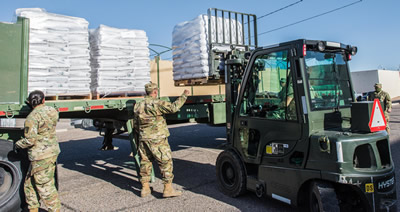
The New Mexico National Guard prepares six deliveries of food and supplies to multiple New Mexico Reservations including Zuni, Laguna, Mescalero, Santa Domingo, San Juan, and Jicarilla. AI/AN have been hit especially hard by the pandemic.
Photo by Senior Airman Ian Beckley
ATLANTA—Non-Hispanic American Indians and Alaska Natives make up only 0.7% of the United States population but 13% of coronavirus disease cases across the country, according to a new report.
The national Centers for Disease Control and Prevention pointed out in an article in its Morbidity & Mortality Weekly Report that, in 23 states with adequate race/ethnicity data, the cumulative incidence of laboratory-confirmed COVID-19 among AI/AN was 3.5 times that among non-Hispanic whites.1
Yet, the CDC advised that a large percentage of missing data precluded analysis of some characteristics and outcomes. It noted that its report included only one-half of reported laboratory-confirmed COVID-19 cases among AI/AN persons nationwide, and the states that were able to be included represent about one-third of the national AI/AN population
“American Indian and Alaska Native (AI/AN) persons appear to be disproportionately affected by the COVID-19 pandemic; however, limited data are available to quantify the disparity in COVID-19 incidence, severity, and outcomes among AI/AN persons compared with those among other racial/ethnic groups,” agency researchers wrote.
The study team analyzed reports of laboratory-confirmed COVID-19 cases from Jan. 22-July 3, 2020, using data only from 23 states with more than 70% complete race/ethnicity information and five or more laboratory-confirmed COVID-19 cases among both AI/AN persons (alone or in combination with other races and ethnicities) and non-Hispanic white (white) persons.
Among 424,899 COVID-19 cases reported by those states, 80% had complete race/ethnicity information; among these 340,059 cases, 9,072 (2.7%) occurred among AI/AN patients and 138,960 (40.9%) among white patients.
Researchers reported that, among 340,059 cases with complete patient race/ethnicity data, the cumulative incidence among AI/AN persons in these 23 states was 594 per 100,000 AI/AN population (95% confidence interval [CI] = 203–1,740), compared with 169 per 100,000 white population (95% CI = 137–209) (rate ratio [RR] = 3.5; 95% CI = 1.2–10.1).
The CDC emphasized that AI/AN COVID-19 cases involved considerably younger people (median age = 40 years; interquartile range [IQR] = 26–56 years) than those confirmed in white people (median age = 51 years; IQR = 32–67 years).
The authors explained that the disparity in cases is mostly influenced by the elevated rate ratio (RR) in New Mexico, although variability in the RR among states is reflected in the wide confidence interval (95% CI = 1.2, 10.1).
“Among 345,093 COVID-19 cases meeting the study inclusion criteria, 2.7% of cases occurred in AI/AN persons, more than twice the percentage of non-Hispanic AI/AN cases reported in CDC COVID-19 case surveillance data from all states (1.3%),” the study noted. “However, this analysis included AI/AN persons who identified as multiple races and ethnicities, which increased AI/AN case identification by 4%, from 8,691 to 9,072 cases in the 23 states. The higher proportion of AI/AN persons in this analysis is also the result of the more completely reported race/ethnicity data in these states.”
Historical Trauma
In explaining the higher rates, the CDC researchers discussed how “historical trauma and persisting racial inequity have contributed to disparities in health and socioeconomic factors between AI/AN and white populations that have adversely affected AI/AN communities; these factors likely contribute to the observed elevated incidence of COVID-19 among the AI/AN population.”
They also posited that the elevated incidence within that group might also reflect differences in reliance on shared transportation, limited access to running water, household size, and other factors that might facilitate COVID-19 community transmission.
One critical problem was incomplete data, the study team emphasized, stating, “Although the elevated prevalence of underlying health conditions among AI/AN persons is well documented, in this analysis, data on underlying health conditions were unknown or missing for 91.6% of AI/AN patients compared with 72.7% of white patients, preventing examination of the association between underlying health conditions and COVID-19 incidence. The excessive absence of data among AI/AN persons represents an important gap in public health data for AI/AN persons and suggests a need for additional resources to support case investigation and reporting infrastructure in AI/AN communities.”
Data was missing on symptoms, underlying health conditions, hospitalization, ICU admission and death, they added.
Another issue was that AI/AN are often misclassified as non-AI/AN races and ethnicities in epidemiologic and administrative data sets, leading to an underestimation of their morbidity and mortality.
“Despite these limitations, these findings suggest that the AI/AN population in the 23 examined states, particularly AI/AN persons aged <65 years, has been disproportionately affected by the COVID-19 pandemic, compared with the white population,” the authors concluded. “More complete case information is needed to more effectively guide the public health response to COVID-19 among the AI/AN population. The collection of this information can be facilitated by more consistent, complete, and accurate collection and reporting by providers, reporting laboratories, and local, state, federal, and tribal public health practitioners, and ensuring the resources to do so. Race/ethnicity data should be collected following best practices for AI/AN data collection, including allowing for the reporting of multiple races and ethnicities and providing adequate training about asking about race and ethnicity in a culturally sensitive manner.”
They added that, among federally recognized tribes, AI/AN race is a political status that confers access to healthcare services under treaty obligations of the U.S. government, which highlights “the important contribution of adequate health care and public health infrastructure resources to culturally responsive public health efforts intended to sustain the strengths of AI/AN communities.”
- Hatcher SM, Agnew-Brune C, Anderson M, et al. COVID-19 Among American Indian and Alaska Native Persons — 23 States, January 31–July 3, 2020. MMWR Morb Mortal Wkly Rep. ePub: 19 August 2020. DOI: http://dx.doi.org/10.15585/mmwr.mm6934e1

